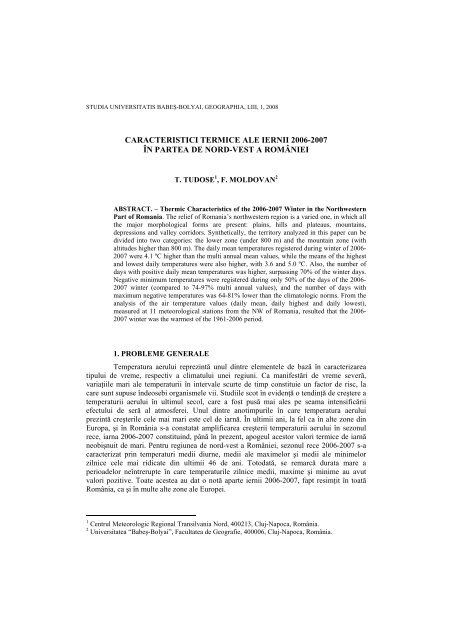studia universitatis babeÅ â bolyai geographia 1
studia universitatis babeÅ â bolyai geographia 1
studia universitatis babeÅ â bolyai geographia 1
You also want an ePaper? Increase the reach of your titles
YUMPU automatically turns print PDFs into web optimized ePapers that Google loves.
STUDIA UNIVERSITATIS BABEŞ-BOLYAI, GEOGRAPHIA, LIII, 1, 2008<br />
CARACTERISTICI TERMICE ALE IERNII 2006-2007<br />
ÎN PARTEA DE NORD-VEST A ROMÂNIEI<br />
T. TUDOSE 1 , F. MOLDOVAN 2<br />
ABSTRACT. – Thermic Characteristics of the 2006-2007 Winter in the Northwestern<br />
Part of Romania. The relief of Romania’s northwestern region is a varied one, in which all<br />
the major morphological forms are present: plains, hills and plateaus, mountains,<br />
depressions and valley corridors. Synthetically, the territory analyzed in this paper can be<br />
divided into two categories: the lower zone (under 800 m) and the mountain zone (with<br />
altitudes higher than 800 m). The daily mean temperatures registered during winter of 2006-<br />
2007 were 4.1 ºC higher than the multi annual mean values, while the means of the highest<br />
and lowest daily temperatures were also higher, with 3.6 and 5.0 ºC. Also, the number of<br />
days with positive daily mean temperatures was higher, surpassing 70% of the winter days.<br />
Negative minimum temperatures were registered during only 50% of the days of the 2006-<br />
2007 winter (compared to 74-97% multi annual values), and the number of days with<br />
maximum negative temperatures was 64-81% lower than the climatologic norms. From the<br />
analysis of the air temperature values (daily mean, daily highest and daily lowest),<br />
measured at 11 meteorological stations from the NW of Romania, resulted that the 2006-<br />
2007 winter was the warmest of the 1961-2006 period.<br />
1. PROBLEME GENERALE<br />
Temperatura aerului reprezintă unul dintre elementele de bază în caracterizarea<br />
tipului de vreme, respectiv a climatului unei regiuni. Ca manifestări de vreme severă,<br />
variaŃiile mari ale temperaturii în intervale scurte de timp constituie un factor de risc, la<br />
care sunt supuse îndeosebi organismele vii. Studiile scot în evidenŃă o tendinŃă de creştere a<br />
temperaturii aerului în ultimul secol, care a fost pusă mai ales pe seama intensificării<br />
efectului de seră al atmosferei. Unul dintre anotimpurile în care temperatura aerului<br />
prezintă creşterile cele mai mari este cel de iarnă. În ultimii ani, la fel ca în alte zone din<br />
Europa, şi în România s-a constatat amplificarea creşterii temperaturii aerului în sezonul<br />
rece, iarna 2006-2007 constituind, până în prezent, apogeul acestor valori termice de iarnă<br />
neobişnuit de mari. Pentru regiunea de nord-vest a României, sezonul rece 2006-2007 s-a<br />
caracterizat prin temperaturi medii diurne, medii ale maximelor şi medii ale minimelor<br />
zilnice cele mai ridicate din ultimii 46 de ani. Totodată, se remarcă durata mare a<br />
perioadelor neîntrerupte în care temperaturile zilnice medii, maxime şi minime au avut<br />
valori pozitive. Toate acestea au dat o notă aparte iernii 2006-2007, fapt resimŃit în toată<br />
România, ca şi în multe alte zone ale Europei.<br />
1 Centrul Meteorologic Regional Transilvania Nord, 400213, Cluj-Napoca, România.<br />
2 Universitatea “Babeş-Bolyai”, Facultatea de Geografie, 400006, Cluj-Napoca, România.
















